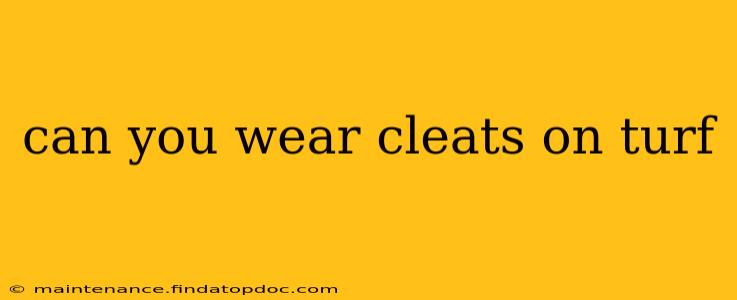Can You Wear Cleats on Turf? A Comprehensive Guide
The short answer is: it depends. While you can wear cleats on turf, it's not always the best idea, and doing so can have consequences for both your performance and the condition of the field. This guide will delve into the nuances of wearing cleats on turf, addressing common concerns and offering expert advice.
Understanding Turf Types
Before we dive into the suitability of cleats, it's crucial to understand that "turf" isn't a monolithic entity. There are several types, each with varying levels of surface texture and firmness:
-
Artificial Turf (Synthetic Turf): This is the most common type of turf, composed of synthetic fibers. There's a wide variety in the quality and type of fibers, impacting how cleats interact. Some artificial turfs have a very short pile, while others have a longer, more plush feel. The infill material (often rubber or sand) also plays a role in overall firmness.
-
Natural Turf (Grass): While generally understood to be separate from "turf", it is worth noting. Cleats are designed for grass and will generally perform best and cause least damage on this surface.
The suitability of cleats depends heavily on the specific type of artificial turf.
What Happens When You Wear Cleats on Turf?
Potential Benefits:
- Grip (in some cases): On some firmer artificial turfs, cleats might provide a slight advantage in grip, particularly during sudden acceleration or deceleration. However, this is not always the case and it depends on the design and type of cleat.
Potential Drawbacks:
-
Damage to the Turf: Cleats can tear or puncture the turf fibers, leading to uneven surfaces and potentially shortening the lifespan of the field. The more aggressive the cleat design, the greater the risk of damage.
-
Reduced Traction (often): On softer or longer-pile artificial turfs, the cleats can get caught, leading to reduced traction and an increased risk of injury. This is because the cleats are designed to penetrate the ground, not get caught in fibers.
-
Increased Risk of Injury: The unpredictable nature of traction on turf when wearing cleats increases the chance of ankle sprains, knee injuries, and other similar issues.
What are the Alternatives to Cleats on Turf?
For optimal performance and to protect the turf, consider these alternatives:
-
Turf Shoes: These shoes are specifically designed for artificial turf and have shorter, more numerous studs or a flat sole for improved traction and reduced damage to the playing surface. They offer a balance between grip and protection.
-
Firm Ground (FG) Boots: These are a middle ground between cleats and turf shoes, boasting a more substantial stud than turf trainers but a less aggressive design than many cleats. It depends on the type of FG boots, however. Some are suited to artificial turf, while others are not.
-
Multi-Ground (MG) Boots: These are typically suitable for a variety of surfaces, including artificial grass, but may be less specialized than turf shoes or dedicated firm ground boots for specific artificial turf use.
What type of cleats are best for turf? (If you must wear cleats)
If you absolutely must use cleats on artificial turf, choose those with shorter, less aggressive studs. Avoid metal cleats on artificial turf, as these are most likely to damage the surface.
Are molded cleats better than metal cleats on turf?
Molded cleats are generally better for artificial turf compared to metal cleats because they are less likely to puncture or severely damage the fibers. Metal cleats will cause more damage and could lead to dangerous holes in the playing surface.
Can you wear football cleats on turf?
While technically possible, it's generally not recommended. Football cleats are often designed with aggressive studs for gripping natural grass, which can damage artificial turf and reduce traction. Turf shoes or shoes designed for artificial turf are a much safer and more effective choice.
In conclusion, while wearing cleats on turf is possible, it's often not the best practice. Understanding the type of turf and choosing appropriate footwear is crucial for both performance and field preservation. Turf shoes are generally the recommended option. Always prioritize safety and field integrity.
